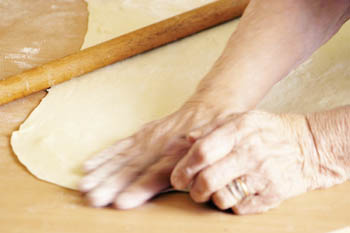![[Metroactive Dining]](/dining/gifs/dining468.gif)
[ Dining Index | Santa Cruz | Metroactive Home | Archives ]
Old World, New World
A traditional Slovak holiday meal--the kind that's been carried over for generations--overwhelms our resident foodie
By Steve Billings
It's four o'clock on Christmas Eve and the preparations for Holy Supper are well under way. The kitchen is humming with activity, the windows in the adjoining room steamed already. A huge pot of water boils on the stove, expectant. Rounds of uncooked dough crowd together atop the chopping block in the middle of the room, wrapped in plastic, staying moist. Bowls of sauerkraut, red cabbage, kale, and potatoes and cheese color the countertop next to the stove. Marlene, my girlfriend's mother, lets no space goes unused.
Meanwhile, My girlfriend, Zoe, is rolling out dough with her grandmother's white marble pin, working it into a sheet that is both thin and strong. The dough is then sectioned into squares, filled with a dollop of sauerkraut, folded over and pinched shut. We will do the same thing many times over until all of the fillings are used. A pirohi is born once again.
The pirohi is the raviolilike centerpiece of the Holy Supper meal that my girlfriend's family has been preparing each Christmas Eve since long before her great-grandparents, Peter and Mary Sovyak, immigrated to Pittsburgh, Penn., from Slovakia in the 1920s. Back then, their neighborhood was populated with a few hundred working-class families of Slavic origin, a neighborhood they all referred to as Ruska Doliny, which Marlene describes as "a poor neighborhood at the end of a street, which you didn't go into unless you lived there." Most of the family lives in California now, but the traditions carry on.
The meal still begins with a mushroom soup whose broth is based on sauerkraut juice and browned flour. Some would call it an acquired taste, but when the broth is not overly potent and the sourness is balanced, the soup shines and wakes you up. This is eaten with a round, almost focaccia-type bread called pagach that is sometimes piled in the middle of the table to reflect Jesus as the bread of life. After this come the pirohis, which, when they are made right (as they were this year), are near the apex of comfort food.
Yet even before we sit down at the table to eat, there are ceremonial touches to be done. Marlene lights the Holy Candle, blessed by the church, symbolizing the Star of Bethlehem. We then pass around a bowl of silver change, washing our hands in money, encouraging and inviting prosperity in the coming year. She then goes around the table giving each of us the sign of the cross marked in honey on our foreheads in hopes that the "lives of all present will be sweet without any bitterness."
We then pass around a bowl containing cloves of raw peeled garlic to be eaten (with a bit of honey after) for its healthful benefits and ability to keep away evil spirits.
This year our prayers were said for us some 3,000 miles away by the oldest member of the family, Marlene and Patrice's 85-year-old aunt MaryAnne from Pittsburgh. As we sat at the table with only the candle lighted on the table, Marlene played back the long voicemail left by her aunt. It was a few minutes long, some of it spoken words, some song, all of it in Slovak.
Of course, I understood nothing as she sang and prayed. I just listened, letting the words and what felt like kindness run over me. After all these years, new traditions keep arising.
[ Santa Cruz | Metroactive Central | Archives ]
Copyright © Metro Publishing Inc. Maintained by Boulevards New Media.
For more information about Santa Cruz, visit santacruz.com.
![]()

Is It Rolling, Steve?: In a traditional Slovak holiday meal, the dough is rolled to make pirohis, the raviolilike centerpiece of the feast.
From the January 5-12, 2005 issue of Metro Santa Cruz.